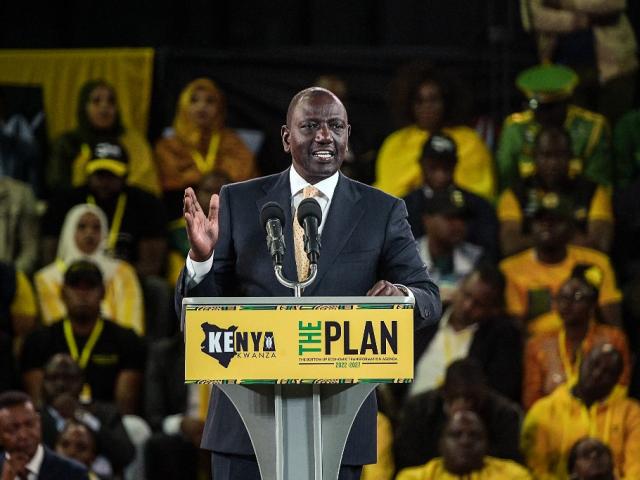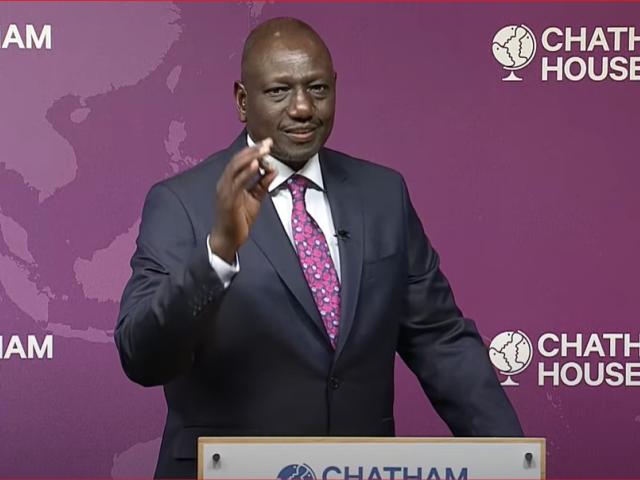-
During his chat with journalists, Ruto was correct to claim that his government had lowered the cost of fertiliser.
-
He was also right that a gas power plant produced expensive electricity, while hydropower was much cheaper. A claim about geothermal energy was unproven.
-
He was incorrect to say that Kenya had the third highest number of livestock in Africa. But a claim about the size of the country’s economy “in the region” was mostly correct.
For the first time since he was elected, Kenyan president William Ruto invited members of the media to a discussion at State House, his official residence.
He answered questions about topics such as his administration’s promises to create jobs, lower the cost of living, boost food security and improve manufacturing.
Africa Check vetted six of his claims.
We asked spokesperson Hussein Mohamed for the source of the president’s data. Mohamed said he would send it to us, and we will update this report when we get it.
Fertilisers contain chemicals that help improve the growth and productivity of plants.
Agriculture makes up a fifth (22.4%) of Kenya’s gross domestic product (GDP), a common measure of the size of an economy.
When Ruto was sworn in on 13 September 2022, he promised to lower the price of a 50 kilogram bag of fertiliser from KSh6,500 (about US$50) to KSh3,500 ($30). This was just before the start of Kenya’s rainy season, which runs from October to December.
The agriculture ministry announced the lower price a week later. It said farmers could buy the subsidised fertiliser from the National Cereals and Produce Board. The board later posted photos online of farmers collecting the fertiliser.
In October farmers interviewed by the media said that they had bought the fertiliser at the lower price. We therefore rate the president’s claim as correct.
Commercial fertiliser prices remain high
But it’s a different story on the open market. Here a 50kg bag of fertiliser can cost more than KSh5,000 ($40), and in some instances as much as KSh9,000 ($70).
A 2018 study by the Alliance for Green Revolution, a nonprofit working in 11 African countries, estimated that private importers provide half the fertiliser used in Kenya. – Dancan Bwire
The gas turbine plant in Muhoroni, a town in southwestern Kenya about 300 kilometres from the capital Nairobi, has a capacity of 60 megawatts (MW).The plant helps stabilise the fragile power grid in western Kenya.
Thermal power plants – like the Muhoroni gas plant – burn fuel that boils water, producing steam. The steam then drives electricity generators. This is in contrast to hydropower plants, where falling water drives the generators.
Ruto used the Muhoroni plant as an example of the high cost of energy in Kenya, due to thermal generation. He compared it to the cost of electricity from hydropower sources, produced at four US cents per kilowatt hour.
A kilowatt hour (KWh) measures the energy used by an electrical device. It’s the measure seen on your electricity bill.
The Kenya Electricity Generating Company (KenGen) operates the Muhoroni plant and sells the electricity generated to Kenya Power, the state utility.
Kenya Power said they would send us information on the plant, but have not yet done so. A presidential task force reviewing controversial power purchase agreements in Kenya has also struggled to access this information.
So we checked the firm’s most recent annual report. In the 2021/22 financial year, Kenya Power bought 40 gigawatt hours (GWh), or 40 million KWh, from the Muhoroni plant at KSh2.03 billion. This works out to KSh50.69 for every kilowatt hour. (Note: The World Bank calculates the cost of power in dollars per kilowatt hour.)
In 2021, according to the most recent economic survey from the Kenya National Bureau of Statistics, one US dollar cost an average of KSh109.65. At that rate, Kenya Power bought each kilowatt hour from Muhoroni for 46.23 US cents.
The gas plant’s output accounted for only 0.5% of the 7,911 GWh the utility bought that financial year. But proportionately, it cost nearly 10 times this, or 4.2%, of the total KSh48.4 billion Kenya Power spent to buy electricity.
Ruto’s claim about the plant’s high cost is mostly correct. – Makinia Juma
KenGen produces electricity from 14 hydropower plants. (Note: See here for more details about how electricity is generated.)
Nine of these – including Gitaru, Kiambere and Turkwel – are large plants. Five are much smaller.
In the 2021/22 financial year, Kenya Power bought 3,157 GWh, or 3.157 billion KWh, from eight of the large plants. This works out to KSh2.74 per KWh.
The Sang’oro station is one of the nine larger hydros, but for unclear reasons is treated separately in the annual report. The bill for the 10 GWh, or 110 million KWh, bought from the plant comes to KSh752 million, or KSh6.83 per KWh.
The average cost of electricity from the large hydros is therefore KSh4.79. This works out to 4.36 US cents at the 2021 exchange rate of KSh109.65.
The report also lumps wind power with the small hydropower stations. Without more detailed data from Kenya Power, we are unable to work out an exact figure.
But the available data does back up Ruto’s claim. – Makinia Juma
We asked the State House spokesperson what Ruto meant by “capped” geothermal energy. We will update this report should we hear back.
Geothermal energy is the natural heat stored in the earth’s crust. To produce it, wells are drilled deep underground, and the resulting steam drives large turbines that produce electricity.
Kenya has geothermal potential of up to 10,000 MW, according to the country’s energy regulator. So far, 828 MW is “installed capacity”, or “the maximum theoretical electric output a power station can produce when operating at 100%”. (Note: Kenya Power has a higher figure of 950 MW.)
In its most recent annual report, published in 2020, the state-run Geothermal Development Company said it had a target of increasing its capacity to 1,065 MW, by 2030.
Projects totalling 430 MW are in development, according to the chief executive’s statement in the report. Most of this is in partnership with KenGen, which put out a statement on the day Ruto spoke to the media.
There is publicly available data showing that 400 MW or so is being developed. But without confirmation from Ruto’s spokesperson it is unclear whether the president was referring to this. – Grace Gichuhi
In making this claim, the president was talking about the potential of Kenya’s leather industry. We traced the claim to a 2015 World Bank study on the industry. This said that “Kenya is the third largest livestock holder in Africa”.
Dr Timothy Njagi is a research fellow at the Tegemeo Institute of Agriculture Policy and Development, an agriculture policy think tank in Kenya. He said we should check with the UN Food and Agriculture Organization (FAO) for data on livestock numbers.
FAO lists 18 categories of livestock, from bees and chickens to buffalos, cattle and horses.
Njagi said we should focus on camels, cattle, goats and sheep as these are “referred to as traditional livestock.” They are also the animals listed in 2012 government research on the leather industry.
Njagi also said that since the Covid pandemic, Kenya has lost a significant number of its poultry, as farmers opted out due to high food costs. This volatility is also why our focus is on “traditional” livestock.
FAO uses the official numbers. When these are unavailable, it turns to “non-official sources or historical data”. The agency’s most recent figures are from 2021.
Below is a ranking of African countries by livestock holding:
|
Top African countries by traditional livestock numbers |
||
|
Rank |
Country |
Number |
|
1 |
Ethiopia |
153,336,110 |
|
2 |
Nigeria |
146,386,010 |
|
3 |
Chad |
128,196,687 |
|
4 |
Sudan |
110,399,490 |
|
5 |
Kenya |
84,653,025 |
|
6 |
Mali |
64,490,817 |
|
7 |
Tanzania |
58,513,921 |
|
8 |
Niger |
52,708,573 |
|
9 |
South Sudan |
42,018,450 |
|
10 |
Burkina Faso |
38,832,387 |
Source: FAO 2021. See our calculations here.
By this breakdown, Kenya has the fifth – not third – highest number of livestock in Africa.
The chief statistician at the FAO also told Africa Check that “Kenya is not the third-largest livestock holder in Africa regardless of any type of livestock”.
The organisation used numbers from the Kenya National Bureau of Statistics on livestock production and data on livestock, and the net livestock trade, or total imports less exports.
The agency also shared this table from their publicly available database that shows “live animals”.
“The analysis shows that in 2020/21, Kenya is the eighth livestock holder in Africa (all types of livestock combined),” the FAO said in an email.
“It should be noted that different data sources and methods to derive figures used to rank countries will give different rankings.” – Tess Wandia
Ruto made this claim during a discussion of Kenya’s interventions in conflicts in several African countries. We have asked his spokesperson what he meant by “region”.
Kenya has its military in missions in the Democratic Republic of Congo (DRC) and Somalia.
Former Kenyan president Uhuru Kenyatta is mediating the conflicts in the DRC and Ethiopia, while the government is also concerned about conflict in South Sudan.
During the discussion, Ruto said that he travelled to Ethiopia, Uganda, DRC, and South Sudan in 2022 to discuss regional stability.
“We have a huge interest in the stability of this region. If this region is unstable, the biggest hit will be on our economy,” he said.
Kenya shares a border with five countries: Uganda, Tanzania, South Sudan, Somalia and Ethiopia.
It is also part of the East Africa Community (EAC), made up of seven countries – Uganda, Tanzania, South Sudan, DRC, Rwanda and Burundi.
Kenya, Somalia, Uganda and Ethiopia are part of the Intergovernmental Authority on Development (Igad), which has eight members. The others are South Sudan, Sudan, Djibouti and Eritrea.
Then there is the Eastern Africa Standby Force, a combined military set up to “enhance peace and security in the eastern Africa region”. Its 10 members are Burundi, Comoros, Djibouti, Ethiopia, Kenya, Rwanda, Seychelles, Somalia, Sudan and Uganda.
What the data shows
We checked for the most recent data from the World Bank and the International Monetary Fund on the 14 countries mentioned above.
The World Bank’s most recent GDP data is for 2021. But it last tracked Eritrea’s GDP in 2011, and South Sudan’s in 2015.
The data shows that in the EAC, Kenya has the largest economy, at US$110.3 billion. It has the second largest economy in the Igad region, after Ethiopia’s $111.3 billion.
The IMF released new GDP estimates in October 2022, showing that Kenya was the largest economy among the 14 countries. The IMF data also shows the Kenyan economy has consistently outperformed Ethiopia’s.
Here is a table showing the breakdown, region and size of the economy based on the two data sources.
Therefore we rate Ruto’s claim as mostly correct. – Tess Wandia
Editor's note: This article was updated on 27 January 2022 to include comments and data from the Food and Agricultural Organization (FAO). This does not change the verdict.







Add new comment